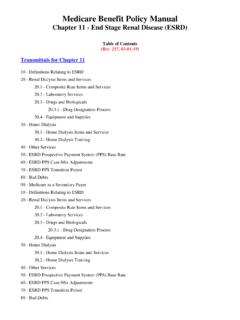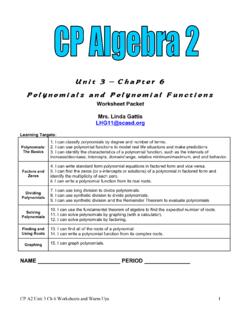Transcription of CHAPTER Neural Networks and Neural Language Models
1 Speech and Language Processing. Daniel Jurafsky & James H. Martin. Copyright 2021. Allrights reserved. Draft of December 29, Networks and NeuralLanguage Models [M]achines of this character can behave in a very complicated manner whenthe number of units is large. Alan Turing (1948) Intelligent Machines , page 6 Neural Networks are a fundamental computational tool for Language process-ing, and a very old one. They are called Neural because their origins lie in theMcCulloch-Pitts neuron(McCulloch and Pitts, 1943), a simplified model of thehuman neuron as a kind of computing element that could be described in terms ofpropositional logic. But the modern use in Language processing no longer draws onthese early biological , a modern Neural network is a network of small computing units, eachof which takes a vector of input values and produces a single output value.
2 In thischapter we introduce the Neural net applied to classification. The architecture weintroduce is called afeedforward networkbecause the computation proceeds iter-feedforwardatively from one layer of units to the next. The use of modern Neural nets is oftencalleddeep learning, because modern Networks are oftendeep(have many layers).deep learningNeural Networks share much of the same mathematics as logistic regression. Butneural Networks are a more powerful classifier than logistic regression, and indeed aminimal Neural network (technically one with a single hidden layer ) can be shownto learn any net classifiers are different from logistic regression in another way. Withlogistic regression, we applied the regression classifier to many different tasks bydeveloping many rich kinds of feature templates based on domain knowledge. Whenworking with Neural Networks , it is more common to avoid most uses of rich hand-derived features, instead building Neural Networks that take raw words as inputsand learn to induce features as part of the process of learning to classify.
3 We sawexamples of this kind of representation learning for embeddings in CHAPTER 6. Netsthat are very deep are particularly good at representation learning. For that reasondeep Neural nets are the right tool for large scale problems that offer sufficient datato learn features this CHAPTER we ll introduce feedforward Networks as classifiers, and also ap-ply them to the simple task of Language modeling: assigning probabilities to wordsequences and predicting upcoming words. In subsequent chapters we ll introducemany other aspects of Neural Models , such asrecurrent Neural networksand theTransformer( CHAPTER 9), contextual embeddings likeBERT( CHAPTER 11), andencoder-decodermodels andattention( CHAPTER 10).2 CHAPTER7 NEURALNETWORKS UnitsThe building block of a Neural network is a single computational unit. A unit takesa set of real valued numbers as input, performs some computation on them, andproduces an its heart, a Neural unit is taking a weighted sum of its inputs, with one addi-tional term in the sum called abias term.
4 Given a set of , a unit hasbias terma set of corresponding a biasb, so the weighted sumzcan berepresented as:z=b+ iwixi( )Often it s more convenient to express this weighted sum using vector notation; recallfrom linear algebra that avectoris, at heart, just a list or array of numbers. Thusvectorwe ll talk aboutzin terms of a weight vectorw, a scalar biasb, and an input vectorx, and we ll replace the sum with the convenientdot product:z=w x+b( )As defined in Eq. ,zis just a real valued , instead of usingz, a linear function ofx, as the output, Neural unitsapply a non-linear functionftoz. We will refer to the output of this function astheactivationvalue for the unit,a. Since we are just modeling a single unit, theactivationactivation for the node is in fact the final output of the network , which we ll generallycally. So the valueyis defined as:y=a=f(z)We ll discuss three popular non-linear functionsf()below (the sigmoid, the tanh,and the rectified linear unit or ReLU) but it s pedagogically convenient to start withthesigmoidfunction since we saw it in CHAPTER 5:sigmoidy= (z) =11+e z( )The sigmoid (shown in Fig.)
5 Has a number of advantages; it maps the outputinto the range[0,1], which is useful in squashing outliers toward 0 or 1. And it sdifferentiable, which as we saw in Section??will be handy for sigmoid function takes a real value and maps it to the range[0,1]. It isnearly linear around 0 but outlier values get squashed toward 0 or Eq. into Eq. gives us the output of a Neural unit:y= (w x+b) =11+exp( (w x+b))( ) UNITS3 Fig. shows a final schematic of a basic Neural unit. In this example the unittakes 3 input valuesx1,x2, andx3, and computes a weighted sum, multiplying eachvalue by a weight (w1,w2, andw3, respectively), adds them to a bias termb, and thenpasses the resulting sum through a sigmoid function to result in a number between 0and b +1zaFigure Neural unit, taking 3 inputsx1,x2, andx3(and a biasbthat we represent as aweight for an input clamped at +1) and producing an output y.
6 We include some convenientintermediate variables: the output of the summation,z, and the output of the sigmoid,a. Inthis case the output of the unityis the same asa, but in deeper Networks we ll reserveytomean the final output of the entire network , leavingaas the activation of an individual s walk through an example just to get an intuition. Let s suppose we have aunit with the following weight vector and bias:w= [ , , ]b= would this unit do with the following input vector:x= [ , , ]The resulting outputywould be:y= (w x+b) =11+e (w x+b)=11+e (.5 .2+.6 .3+.1 .9+.5)=11+e practice, the sigmoid is not commonly used as an activation function. A functionthat is very similar but almost always better is thetanhfunction shown in Fig. ;tanhtanh is a variant of the sigmoid that ranges from -1 to +1:y=tanh(z) =ez e zez+e z( )The simplest activation function, and perhaps the most commonly used, is the rec-tified linear unit, also called theReLU, shown in Fig.
7 It s just the same aszReLUwhenzis positive, and 0 otherwise:y=ReLU(z)=max(z,0)( )These activation functions have different properties that make them useful for differ-ent Language applications or network architectures. For example, the tanh functionhas the nice properties of being smoothly differentiable and mapping outlier valuestoward the mean. The rectifier function, on the other hand has nice properties that4 CHAPTER7 NEURALNETWORKS ANDNEURALLANGUAGEMODELS(a)(b)Figure tanh and ReLU activation from it being very close to linear. In the sigmoid or tanh functions, very highvalues ofzresult in values ofythat aresaturated, , extremely close to 1, and havesaturatedderivatives very close to 0. Zero derivatives cause problems for learning, because aswe ll see in Section , we ll train Networks by propagating an error signal back-wards, multiplying gradients (partial derivatives) from each layer of the network .
8 Gradients that are almost 0 cause the error signal to get smaller and smaller until it istoo small to be used for training, a problem called thevanishing don t have this problem, since the derivative of ReLU for high values ofzis 1 rather than very close to The XOR problemEarly in the history of Neural Networks it was realized that the power of Neural net-works, as with the real neurons that inspired them, comes from combining theseunits into larger of the most clever demonstrations of the need for multi-layer Networks wasthe proof by Minsky and Papert (1969) that a single Neural unit cannot computesome very simple functions of its input. Consider the task of computing elementarylogical functions of two inputs, like AND, OR, and XOR. As a reminder, here arethe truth tables for those functions:AND OR XORx1 x2y x1 x2y x1 x2y0 00 0 00 0 000 10 0 11 0 111 00 1 01 1 011 11 1 11 1 10 This example was first shown for theperceptron, which is a very simple neuralperceptronunit that has a binary output and doesnothave a non-linear activation function.
9 Theoutputyof a perceptron is 0 or 1, and is computed as follows (using the same weightw, inputx, and biasbas in Eq. ):y={0,ifw x+b 01,ifw x+b>0( ) THEXORPROBLEM5It s very easy to build a perceptron that can compute the logical AND and ORfunctions of its binary inputs; Fig. shows the necessary +1-111x1x2+1011(a)(b)Figure weightswand biasbfor perceptrons for computing logical functions. Theinputs are shown asx1andx2and the bias as a special node with value+1 which is multipliedwith the bias weightb. (a) logical AND, showing weightsw1=1 andw2=1 and bias weightb= 1. (b) logical OR, showing weightsw1=1 andw2=1 and bias weightb=0. Theseweights/biases are just one from an infinite number of possible sets of weights and biases thatwould implement the turns out, however, that it s not possible to build a perceptron to computelogical XOR! (It s worth spending a moment to give it a try!)}
10 The intuition behind this important result relies on understanding that a percep-tron is a linear classifier. For a two-dimensional inputx1andx2, the perceptronequation,w1x1+w2x2+b=0 is the equation of a line. (We can see this by puttingit in the standard linear format:x2= ( w1/w2)x1+ ( b/w2).) This line acts as adecision boundaryin two-dimensional space in which the output 0 is assigned to alldecisionboundaryinputs lying on one side of the line, and the output 1 to all input points lying on theother side of the line. If we had more than 2 inputs, the decision boundary becomesa hyperplane instead of a line, but the idea is the same, separating the space into shows the possible logical inputs (00,01,10, and11) and the line drawnby one possible set of parameters for an AND and an OR classifier. Notice that thereis simply no way to draw a line that separates the positive cases of XOR (01 and 10)from the negative cases (00 and 11).













